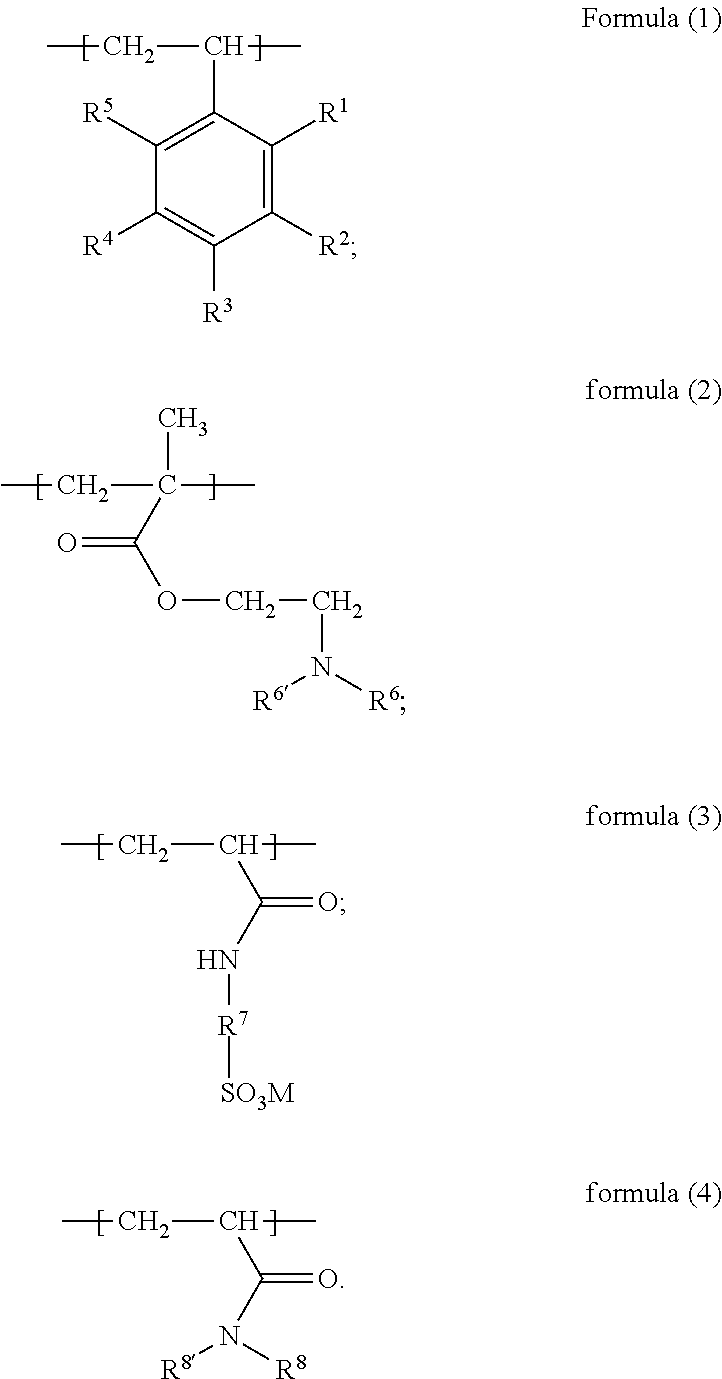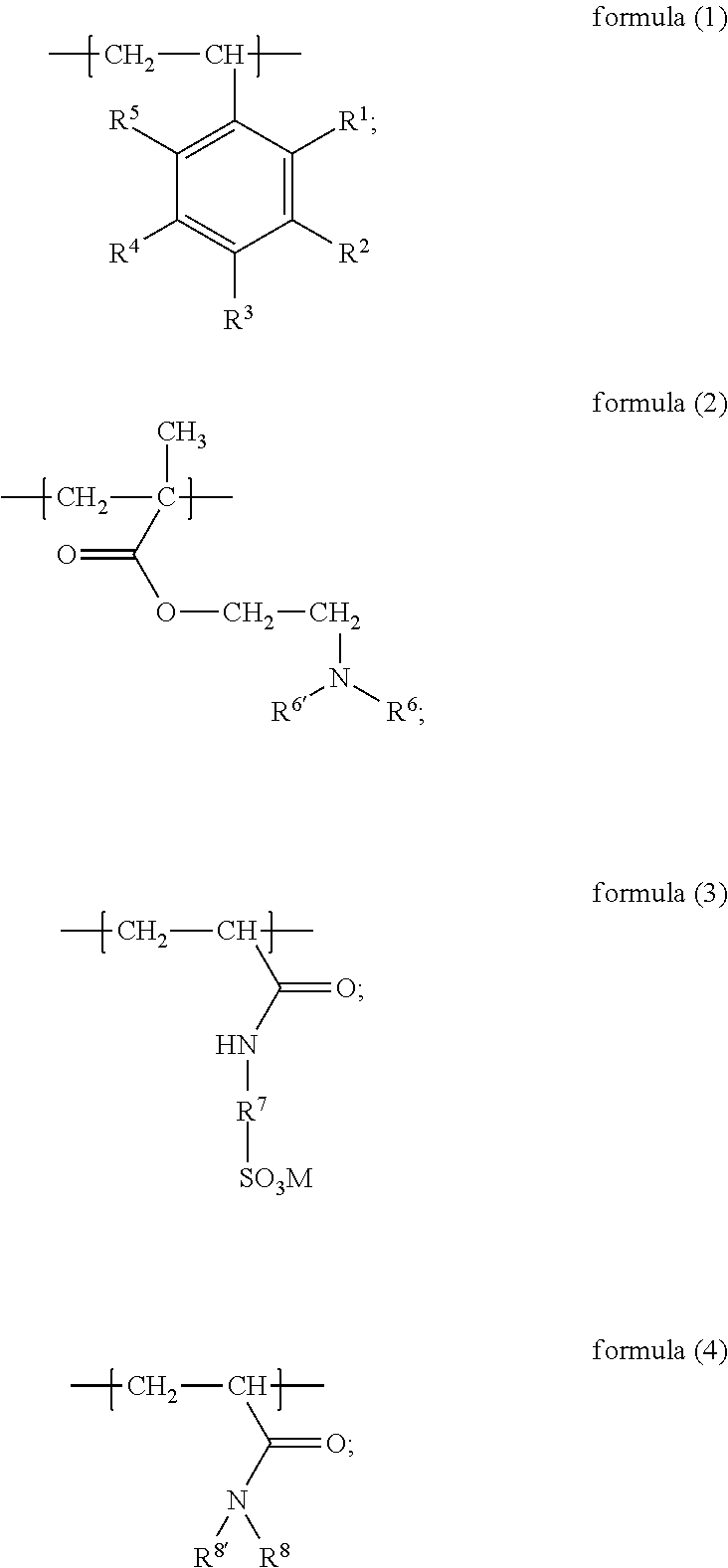Amphiphilic reservoir protecting agent and preparation method thereof and drilling fluid
- Summary
- Abstract
- Description
- Claims
- Application Information
AI Technical Summary
Benefits of technology
Problems solved by technology
Method used
Image
Examples
example 1
[0050]This example is provided to describe the amphiphilic reservoir protecting agent and the method for preparation of the amphiphilic reservoir protecting agent in the present subject matter.
[0051]Add styrene (15 g, 0.14 mol), N,N-dimethylamino ethyl methacrylate (11.3 g, 0.072 mol), 2-acrylamide-2-methyl propanesulfonic acid (14.9 g, 0.072 mol) and N,N-diethylacrylamide (3.66 g, 0.029 mol) into 100 mL water and stir into an emulsion, feed nitrogen into the emulsion for 30 min., heat up the emulsion to 70° C., and add 0.5 g of 4,4′-azobis(4-cyanovaleric acid), and then further heat up to 75° C. and hold at the temperature for 6 h; after the reaction is completed, cool down the reaction solution to room temperature (about 20° C.), evaporate the aqueous dispersion of the product with a rotary evaporator, and grind the obtained solid to powder state; thus, 43.45 g solid amphiphilic reservoir protecting agent (yellowish powder) is obtained, which is the amphiphilic reservoir protectin...
example 2
[0052]This example is provided to describe the amphiphilic reservoir protecting agent and the method for preparation of the amphiphilic reservoir protecting agent in the present subject matter.
[0053]Add 4-methoxystyrene (17 g, 0.13 mol), N,N-diethylamino ethyl methacrylate (24.1 g, 0.13 mol), 2-acrylamide-2-methyl propanesulfonic acid (26.94 g, 0.13 mol) and N,N-dimethylacrylamide (4.95 g, 0.05 mol) into 100 mL water and stir into an emulsion, feed nitrogen into the emulsion for 40 min., heat up the emulsion to 60° C., and add 0.3 g of azobis(isobutylamidine hydrochloride), and then further heat up to 70° C. and hold at the temperature for 8 h; after the reaction is completed, cool down the reaction solution to room temperature (20° C.), evaporate the aqueous dispersion of the product with a rotary evaporator, and grind the obtained solid to powder state; thus, 69.85 g solid amphiphilic reservoir protecting agent (yellowish powder) is obtained, which is the amphiphilic reservoir pro...
example 3
[0054]This example is provided to describe the amphiphilic reservoir protecting agent and the method for preparation of the amphiphilic reservoir protecting agent in the present subject matter.
[0055]Add styrene (15 g, 0.14 mol), N,N-diethylamino ethyl methacrylate (25.9 g, 0.14 mol), 2-acrylamide-2-methyl propanesulfonic acid (29.85 g, 0.14 mol) and N,N-dihexylacrylamide (3.34 g, 0.014 mol) into 100 mL water and stir into an emulsion, feed nitrogen into the emulsion for 50 min., heat up the emulsion to 75° C., and add 0.3 g of azodiisobutyronitrile, and then further heat up to 80° C. and hold at the temperature for 5 h; after the reaction is completed, cool down the reaction solution to room temperature (20° C.), evaporate the aqueous dispersion of the product with a rotary evaporator, and grind the obtained solid to powder state; thus, 71.55 g solid amphiphilic reservoir protecting agent (yellowish powder) is obtained, which is the amphiphilic reservoir protecting agent described i...
PUM
| Property | Measurement | Unit |
|---|---|---|
| Molar mass | aaaaa | aaaaa |
| Molar mass | aaaaa | aaaaa |
| Amphiphilic | aaaaa | aaaaa |
Abstract
Description
Claims
Application Information
 Login to View More
Login to View More - R&D
- Intellectual Property
- Life Sciences
- Materials
- Tech Scout
- Unparalleled Data Quality
- Higher Quality Content
- 60% Fewer Hallucinations
Browse by: Latest US Patents, China's latest patents, Technical Efficacy Thesaurus, Application Domain, Technology Topic, Popular Technical Reports.
© 2025 PatSnap. All rights reserved.Legal|Privacy policy|Modern Slavery Act Transparency Statement|Sitemap|About US| Contact US: help@patsnap.com



